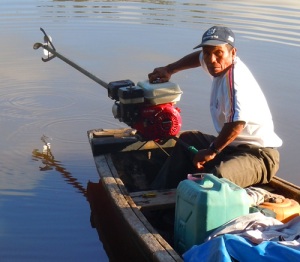
Brillo Nuevo was dark and quiet when we finally pulled in just after 10 pm. Half-way into the rainy season, Oscar drove his boat almost to the back of his house. I took off my shoes and socks to wade through the final few feet to the dry bank. In another two months, I would probably be able to step directly from his boat into his living room on stilts.
Renee, the young President of the community, stopped by briefly to confirm we could meet with the community at 8 o’clock the following morning. Starting then should give us enough time to meet with everyone about the social rebate and then meet with the artisans before Church started.
Yully and I briefly discussed ideas for the social rebate with Oscar. Setting aside 20% of the proceeds of the sales of crafts from Brillo Nuevo had generated a potential fund of about $900 to support health, education or conservation needs in the community of their choosing. We heard people were considering buying more medicines as they had done with the first round of the rebate.
I asked Oscar if he thought folks might want to produce stories or other materials to help kids improve their reading and writing skills in their native Bora language. He said there was a project in progress to do this, but it might be good to consider using some CECAMA (CACE in Spanish) funds for this since the other project seemed uncertain. Oscar wouldn’t be present at the meeting, though, because he going back downriver in a few hours to attend a training session for church pastors. I curled up in my hammock fully dressed with my fleece blanket and read a bit of The Secret Life of Bees with my headlamp before I accepted that involuntary closing of the book during bursts of sleep meant it was time to call it day.
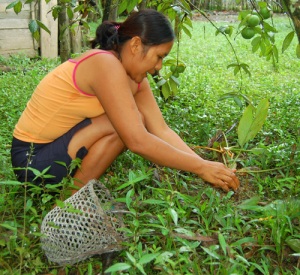 I woke just before dawn and packed up my hammock. I was considering paying a visit to Don Eli and his family to express my condolences about the loss of his 24 year-old daughter Alida. Eli has always been very kind to me and key member of our copal team since my first visit to Brillo Nuevo in 2008. Alida and her sister Dalila were keen participants in our craft group. Shortly after I left Peru last summer Yully wrote me that Alida had gone upriver with her baby, husband, and his mother on a fishing trip. They were camped by the river when a sudden storm blew a tree down on top of them. Only Alida’s mother-in-law survived, and she has still not fully recovered from her injuries. It was extra sad to learn that Alida and her husband had just finished building and moved into a two-story house one month before they were killed in this accident. This house remained vacant since people seemed to view it as haunted or cursed.
I woke just before dawn and packed up my hammock. I was considering paying a visit to Don Eli and his family to express my condolences about the loss of his 24 year-old daughter Alida. Eli has always been very kind to me and key member of our copal team since my first visit to Brillo Nuevo in 2008. Alida and her sister Dalila were keen participants in our craft group. Shortly after I left Peru last summer Yully wrote me that Alida had gone upriver with her baby, husband, and his mother on a fishing trip. They were camped by the river when a sudden storm blew a tree down on top of them. Only Alida’s mother-in-law survived, and she has still not fully recovered from her injuries. It was extra sad to learn that Alida and her husband had just finished building and moved into a two-story house one month before they were killed in this accident. This house remained vacant since people seemed to view it as haunted or cursed.
 Eli and his family had appreciated receiving some photos that I had taken of Alida. A camera shop in Iquitos had edited one shot of the baby and printed it against an angelic celestial background. I was hoping to make and give them a DVD copy of a video-taped interview I made of Alida for them as well that morning, but my computer was unfortunately working too slowly to do this quickly.
Eli and his family had appreciated receiving some photos that I had taken of Alida. A camera shop in Iquitos had edited one shot of the baby and printed it against an angelic celestial background. I was hoping to make and give them a DVD copy of a video-taped interview I made of Alida for them as well that morning, but my computer was unfortunately working too slowly to do this quickly.
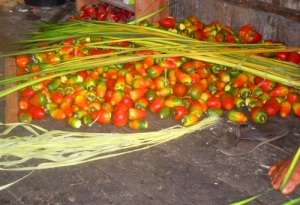 Beder called us over to his house for a quick breakfast prepared by his wife Monica, one of Ena’s younger sisters. I used to ask my hosts to make thick oatmeal the way I am used to it at home, but I now take it the Peruvian way – a thin hot beverage with a tangy bit of cinnamon. This allows one package to serve six instead of one. While we sipped our oatmeal and downed a few pieces of bread, Beder sat next to a big pile of bright red pijuayo palm fruits and snapped leaves off of chambira palm leaves to remove the fiber strips for weaving.
Beder called us over to his house for a quick breakfast prepared by his wife Monica, one of Ena’s younger sisters. I used to ask my hosts to make thick oatmeal the way I am used to it at home, but I now take it the Peruvian way – a thin hot beverage with a tangy bit of cinnamon. This allows one package to serve six instead of one. While we sipped our oatmeal and downed a few pieces of bread, Beder sat next to a big pile of bright red pijuayo palm fruits and snapped leaves off of chambira palm leaves to remove the fiber strips for weaving.
 We wandered down to the “locale” (community meeting building) right at 8 AM, but were not surprised to find that no one was there yet and the front gate was locked. The lady on the other side of the path invited us to wait in her house. Our artisan friends started arriving one by one finally followed by Renee. He didn’t have a key to the “locale” either, but led us into the meeting room through an unlocked back door. I greeted people other people I knew as they filtered in and sat down on sat down on the backless wooden benches. I was particularly happy to see Manuel, the curaca (traditional leader) of the village who had last seemed quite discouraged about the general state of affairs in the village.
We wandered down to the “locale” (community meeting building) right at 8 AM, but were not surprised to find that no one was there yet and the front gate was locked. The lady on the other side of the path invited us to wait in her house. Our artisan friends started arriving one by one finally followed by Renee. He didn’t have a key to the “locale” either, but led us into the meeting room through an unlocked back door. I greeted people other people I knew as they filtered in and sat down on sat down on the backless wooden benches. I was particularly happy to see Manuel, the curaca (traditional leader) of the village who had last seemed quite discouraged about the general state of affairs in the village.
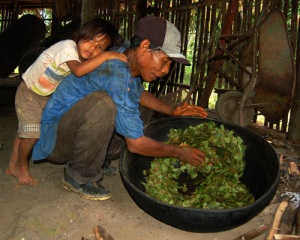 As Christmas traditions, western medicine, gadgets and Peruvian forms of governance became embedded into modern Bora life, his role as the actual village leader dissolved. He ostensibly retained responsibility for cultural affairs, but village interest in holding traditional festivals and the maintaining the maloca (his home) where they are usually held had waned as well. The large manguare drums in the maloca that he and his predecessors used to be beat to call people together are now silent save for brief demonstrations to visitors. I recorded several hours of Manuel telling stories about Bora legends and festivals two years ago that I hope to translate and post online. Manuel had told me he was even thinking of selling these pieces of heritage and moving to the city. He still regularly prepares his coca leaf and cetico bark ash mixture, but he unfortunately has also often had too much alcohol. It seems some people do want to continue organizing traditional festivals from time to time but prefer to do so themselves.
As Christmas traditions, western medicine, gadgets and Peruvian forms of governance became embedded into modern Bora life, his role as the actual village leader dissolved. He ostensibly retained responsibility for cultural affairs, but village interest in holding traditional festivals and the maintaining the maloca (his home) where they are usually held had waned as well. The large manguare drums in the maloca that he and his predecessors used to be beat to call people together are now silent save for brief demonstrations to visitors. I recorded several hours of Manuel telling stories about Bora legends and festivals two years ago that I hope to translate and post online. Manuel had told me he was even thinking of selling these pieces of heritage and moving to the city. He still regularly prepares his coca leaf and cetico bark ash mixture, but he unfortunately has also often had too much alcohol. It seems some people do want to continue organizing traditional festivals from time to time but prefer to do so themselves.
 When a critical mass of people arrived in the new meeting house, Renee, Yully and I sat on a bench behind a table on an elevated cement section in the front of the room and each gave brief into remarks. After assuming that the matter of deciding how to spend the balance of the Brillo Nuevo social rebate account was still open, I threw out my suggestion about using part of the funds to create Bora educational materials. Manuel voiced some support for this, but the matter went no further when Renee surprised both Yully and me by reminding the group that they had already decided in a previous assembly to use these funds to build a community pharmacy. It would be stocked with basic medicines that would be sold to community members at cost. Proceeds would be reinvested to buy new supplies.
When a critical mass of people arrived in the new meeting house, Renee, Yully and I sat on a bench behind a table on an elevated cement section in the front of the room and each gave brief into remarks. After assuming that the matter of deciding how to spend the balance of the Brillo Nuevo social rebate account was still open, I threw out my suggestion about using part of the funds to create Bora educational materials. Manuel voiced some support for this, but the matter went no further when Renee surprised both Yully and me by reminding the group that they had already decided in a previous assembly to use these funds to build a community pharmacy. It would be stocked with basic medicines that would be sold to community members at cost. Proceeds would be reinvested to buy new supplies.
There is a health a post in the village supposedly backed by government assistance, but it has had problems with adequate and honest staffing. I was disturbed to learn that at least some of the medicines bought with our last social rebate fund had been sold by a health technician for his personal profit. The community, therefore, wanted to have a place to manage at least some medicines under their direct control. When Renee asked the assembly, though, to confirm this decision, there was no response. The silence seemed long and awkward to me; perhaps it was just the Bora way of indicating they weren’t ready to decide.
 Eventually Beder spoke up and proposed using the funds to buy basic supplies for all of the school kids – notebooks, pencils, etc. I wasn’t opposed to the idea since we had done this with our first donation to the community, but I was hoping they would choose something other than items that would be consumed in a short time. The robust artisan Ines then proposed building a bridge over a big stream on the trail to Ancon Colonia to help kids from this nearby village walk more easily to the school in Brillo Nuevo. This seemed like a novel idea, but it also went nowhere. People apparently thought Ines was more interested in easing the walk to her farm field on the other side of the stream more than helping bids from the other village commute to Brillo Nuevo.
Eventually Beder spoke up and proposed using the funds to buy basic supplies for all of the school kids – notebooks, pencils, etc. I wasn’t opposed to the idea since we had done this with our first donation to the community, but I was hoping they would choose something other than items that would be consumed in a short time. The robust artisan Ines then proposed building a bridge over a big stream on the trail to Ancon Colonia to help kids from this nearby village walk more easily to the school in Brillo Nuevo. This seemed like a novel idea, but it also went nowhere. People apparently thought Ines was more interested in easing the walk to her farm field on the other side of the stream more than helping bids from the other village commute to Brillo Nuevo.
After half an hour of these fragmented comments, a man who had some community responsibility for health issues voiced his firm support for the pharmacy proposal. Without further prompting from the chair, the gathering clicked into an energized gear. People stood in turn to either endorse or express concerns about the proposal. No one disputed the potential value of a community pharmacy; several did seem convinced the community could not manage it in a fair and efficient way. It was sad to feel that their frequent experience with corruption and incompetence made it difficult for them to believe that successfully organizing this endeavor was even possible. The idea of buying school supplies was briefly revisited, and I wondered if the meeting was heading for an impasse. Renee then asked rhetorically: “the community had already decided to do the pharmacy, did people really want to change their mind?”
I stuck my neck out a bit once more with a reminder that it would be great if the community could have a stated goal that we could promote along with craft sales. They could use the funds available now to build and equip the pharmacy and then consider concrete ways to support education with the next installment. Renee put this idea to the assembly for consideration. It didn’t generate a rousing show of hands, but he noted that enough heads were nodding to consider the proposal adopted. A few people would prepare a list of the materials needed to build the pharmacy and pass it along to Yully to estimate the costs and move forward.
 As the first meeting broke up, Don Eli and I met each other’s eyes and walked toward the center of the room. He was smiling as usual and we hugged. I said softly into his left ear, “I’m so sorry about your daughter.” We faced each other again, and tears fell down both of our cheeks. I had never imagined crying in a room full of Bora natives.
As the first meeting broke up, Don Eli and I met each other’s eyes and walked toward the center of the room. He was smiling as usual and we hugged. I said softly into his left ear, “I’m so sorry about your daughter.” We faced each other again, and tears fell down both of our cheeks. I had never imagined crying in a room full of Bora natives.
 As the artisans coalesced for our second meeting, I sensed some heaviness in the group and imagined they were getting ready to launch into their concerns about pricing. I began by explaining the economic realities of our craft enterprise. As happened with the Huitoto group the day before, our Bora partners seemed to appreciate my openness. It was hard for them to believe that someone could make $65 per hour sitting at a computer to make a website while they spent one or two days collecting, processing, and weaving plants into a craft for $8 to $10. They seemed to trust my assertion, though, that we needed to invest a lot of money to keep buying more crafts from them. Ines definitively stated she wanted to keep working with us.
As the artisans coalesced for our second meeting, I sensed some heaviness in the group and imagined they were getting ready to launch into their concerns about pricing. I began by explaining the economic realities of our craft enterprise. As happened with the Huitoto group the day before, our Bora partners seemed to appreciate my openness. It was hard for them to believe that someone could make $65 per hour sitting at a computer to make a website while they spent one or two days collecting, processing, and weaving plants into a craft for $8 to $10. They seemed to trust my assertion, though, that we needed to invest a lot of money to keep buying more crafts from them. Ines definitively stated she wanted to keep working with us.
We then moved on to other themes such as communication challenges. The pace and heat of one discussion alternately between Spanish and Bora shot above my ability to follow it. At one point I motioned for Yully to let Angelina finish her thoughts on one topic. They finally reached a logical resolution that Yully could pass along dates for her upcoming visits or craft orders to any of three members of the quality control committee if the local coordinator wasn’t available.
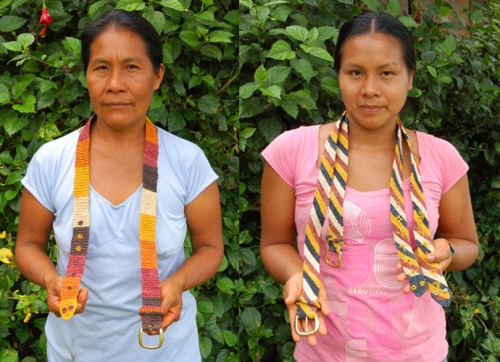 We returned to Oscar’s house to receive completed orders of belts and a few guitar straps. It turned into a spontaneous cooperative craft making session when we found that the holes and loops of many belts were out of place. Angelina’s coral snake models were beautifully woven but were slightly too wide to slide comfortably through the buckle. She went home, carefully removed the excess and came back.
We returned to Oscar’s house to receive completed orders of belts and a few guitar straps. It turned into a spontaneous cooperative craft making session when we found that the holes and loops of many belts were out of place. Angelina’s coral snake models were beautifully woven but were slightly too wide to slide comfortably through the buckle. She went home, carefully removed the excess and came back.
 Ines, Monica, Lucila and a woman who didn’t even make crafts with us adjusted the models made by Ena and others who weren’t there. I was really impressed with the new models of woven net bags that Ines had made and Gisela’s unique multi-colored diagonal belt. Marcelina and kids took turns swaying in a lightweight hammock.
Ines, Monica, Lucila and a woman who didn’t even make crafts with us adjusted the models made by Ena and others who weren’t there. I was really impressed with the new models of woven net bags that Ines had made and Gisela’s unique multi-colored diagonal belt. Marcelina and kids took turns swaying in a lightweight hammock.
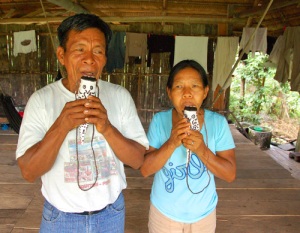 I took photos while Yully recorded and paid people for finished items. Later her husband Aurelio came by with a pair of three pipe bamboo flute inserted in a carved balsa wood model of a sungaro catfish – complete with the black swirly stripes painted on its white body. He and another fellow then played a traditional Bora tune with them. We had hoped to head down river by 11, but we needed a few more hours to get the crafts in order, load the boat and say our goodbyes. It was surreal spending less than 15 hours in the village that’s become my new home base in the Amazon, but it was good to feel I will be welcome again for a more relaxed stay in June.
I took photos while Yully recorded and paid people for finished items. Later her husband Aurelio came by with a pair of three pipe bamboo flute inserted in a carved balsa wood model of a sungaro catfish – complete with the black swirly stripes painted on its white body. He and another fellow then played a traditional Bora tune with them. We had hoped to head down river by 11, but we needed a few more hours to get the crafts in order, load the boat and say our goodbyes. It was surreal spending less than 15 hours in the village that’s become my new home base in the Amazon, but it was good to feel I will be welcome again for a more relaxed stay in June.

Comments will be approved before showing up.


